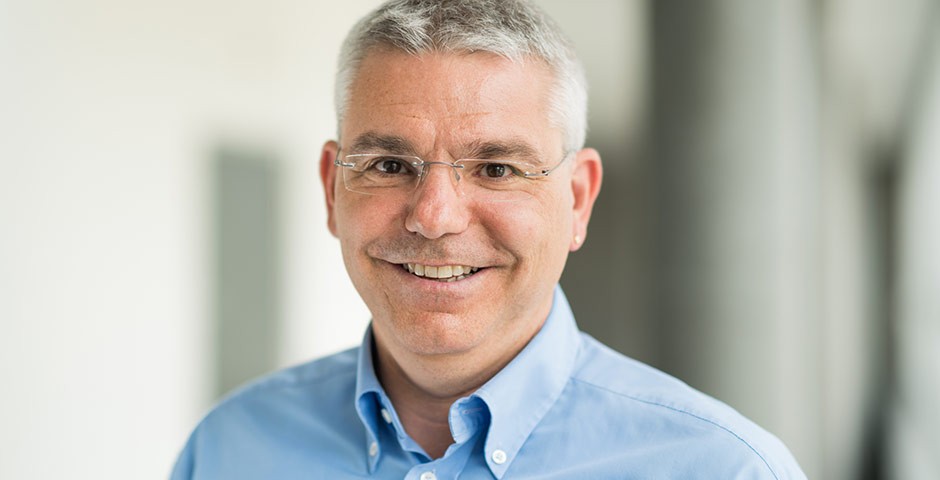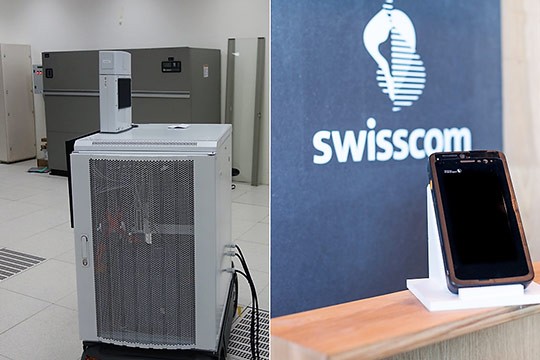
Head of the 5G programme on network expansion
“We plan to bring 5G to 60 towns by the end of 2019.”
5G development is progressing apace. Swisscom presented the first 5G test applications in summer 2017. Today, 5G test networks are in place in Burgdorf, Lausanne, Geneva, Zurich, Bern and Lucerne. Patrick Weibel, Head of the 5G programme at Swisscom, provides an overview of 5G and discusses the next steps in the network expansion.
Michael Lieberherr, 8 November 2018
The first 5G test networks are in place. When will 5G be available across Switzerland?
Our test networks in Burgdorf, Lausanne, Bern, Zurich, Geneva and Lucerne are some of the first in the world. These are not simply demo networks, but completely standardised networks. A successive expansion to around 60 towns and communities by the end of 2019 is currently planned.
What do further expansion plans hinge on?
Firstly, we have to wait for the upcoming ComCom 5G frequency auction, which is planned for January 2019. Further expansion will also be heavily reliant on general political conditions. The ONIR (Ordinance on Protection from Non-ionizing Radiation), which has been in force unchanged since 1999, is ten times more restrictive than in the rest of Europe.
What does this mean for network expansion?
We are stretched to our physical limits by growing volumes of data and the prevailing conditions. In many locations, the allocated spectrum has almost been fully used up on account of these restrictions. The network needs more transmitter sites, and these are difficult to find. Due to the current regulatory framework, therefore, Switzerland is unable to enjoy some of the benefits of 5G.
Many people are not yet making full use of what the 4G network has to offer. So why do we already need 5G?
For most of us, speed is the key consideration. How fast can I surf with my mobile? But that’s just skimming the surface. 4G is an ultra-fast, mobile broadband Internet, exactly as it was designed to be. 5G is a new platform for digitisation that brings much more together. Due to its nature, 5G also offers more opportunities to digitise critical applications. Industries can become more competitive with smart factories – as we demonstrated with Ypsomed. It stands to reason that many applications will only emerge once the infrastructure is up and running. We therefore need the network now, otherwise we’ll miss the boat. Incidentally, this same question was asked previously about 4G..
What is different about 5G?
Mobile networks used to have one main purpose and had to suffice for all other applications. 2G was developed for voice telephony. 3G brought us mobile broadband Internet. 4G took 3G to the next level with much greater bandwidth and network capacities; the focus being smartphones and their applications. In the future, 5G will connect millions of things: devices, machines, buildings, cars and of course, smartphones. These applications make various demands on the network, which for the first time can be handled with the one network. This is the big difference from previous networks.
5G properties
5G will connect millions of devices, things and machines. The technology caters to different application requirements as follows:
More capacity
One radio cell will be able to connect tens of thousands of devices – equipment, things, cars, machines, building components and so forth.
Low latency (response time)
Extremely short latency times enable applications that need haptic feedback, for instance in telemedicine, robotics and gaming.
Speed
Speed will increase hugely and permit new and advanced digital applications in real time.
Edge Computing
Provides the mobile network directly with the processing power necessary to process data in a production machine in real time, for instance.
Network slicing
Bandwidth can be reserved for security or infrastructure-critical applications. An emergency service organisation can therefore be sure of a guaranteed stable connection even in large crowds of people, a street parade for example.
When will the first 5G smartphones come onto the market?
I would expect several manufacturers to present the first devices before or during the Mobile World Congress in Barcelona at the end of February. In November, we were the first company in the world to connect a test device and hotspot to our 5G test network. The device was a smartphone prototype – the chipset of which will be included in the first 5G devices. Just one year ago, these test devices weighed a ton and measured one cubic metre. 5G development is progressing apace.

The test devices reflect this rapid 5G development. In summer 2017, the test device weighed a ton and measured a cubic metre. In November 2018, another test device has now been shrunk to the size of a smartphone and already includes 5G components that will soon be inside the new 5G devices.
How secure is 5G?
As secure as 4G. In the future, 5G will offer even more security functions in additional areas, including for example, the data traffic itself, the identification of network users, security functions for connections through different network providers and security mechanisms for network components. In essence, 5G currently uses the standards of 4G, which are continuously being developed. These will be phased out gradually until we have a purely 5G security architecture.
Will 5G increase emissions?
5G is not fundamentally different to the older 3G (UMTS) or 4G (LTE) technologies. 5G will also be operated in similar frequency ranges to its technology forerunners. In principle, therefore, the results of numerous studies on UMTS and/or LTE signals are still valid. In the area of 5G, we also comply with current regulations, which are precautionarily rigorous in Switzerland.
We will also comply with the reliable limits that have been set for the new frequency ranges above 6 GHz, which 5G will use in the future.
Additional information
Profile
Patrick Weibel heads Swisscom’s 5G programme. He has been there for the development of all the mobile generations.

5G for Switzerland
Swisscom launches the latest mobile generation with its 5G programme.